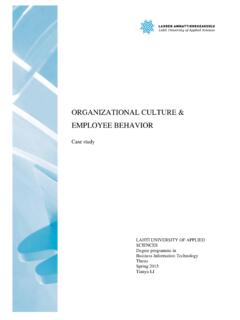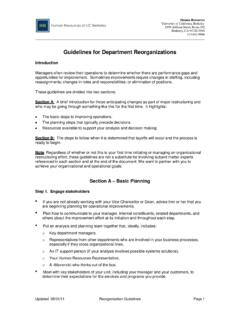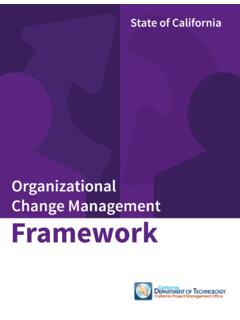Transcription of A Conceptual Framework to Evaluate the Impacts of Water ...
1 A Conceptual Framework to Evaluate the Impacts of Water Safety Plans Centers for Disease Control and Prevention 4770 Buford Highway NE (F-60) Atlanta, GA 30341 Introduction According to the World Health Organization (WHO) Guidelines for Drinking- Water Quality, The most effective means of consistently ensuring the safety of a drinking- Water supply is through the use of a comprehensive risk assessment and risk management approach that encompasses all steps in Water supply from catchment to consumer.
2 In these guidelines, such approaches are called Water safety plans (WSPs) (WHO, 2006). The WHO Guidelines also place WSPs within a larger Framework for safe drinking- Water that includes the public health context and health outcomes and also contains health-based targets and drinking Water surveillance (Fig 1). As such, WSPs are specifically linked to health, with an implicit expectation that implementation of WSPs will safeguard health in areas with acceptable drinking Water quality and improve health in areas with poor drinking Water quality.
3 At a certain level, this expectation of a link between WSPs and health can be taken at face value; ever since John Snow removed the handle of the Broad Street pump, which halted the London cholera outbreak of 1854, there has been a well recognized link between drinking Water safety and health (Paneth, 2004). However, the link between a WSP undertaken for an existing piped drinking Water system and ultimate health outcomes is not as direct as that between the Broad Street Water pump and cholera. Unlike the Broad Street pump, many systems, even prior to WSP initiation, already have multiple barriers between sources of contamination and consumers.
4 Such barriers may include source protection, Water treatment with residual disinfection, safe storage, and a distribution system that prevents recontamination of treated Water . The multiple barrier approach aims to employ as many of these barriers as necessary so that a failure in one area does not immediately expose consumers to unsafe Water . For example, providing a residual disinfectant may counter the effects of leaks in the distribution system that could lead to recontamination after treatment. Therefore, many intervening factors can come between implementation of an individual WSP and ultimate health outcomes.
5 Some examples may include operational factors such as continuity of service, or institutional factors such as better training for employees that results in improved protection of Water safety. Evaluating the Impacts of a WSP, therefore, requires a much broader analysis than simply looking at health improvements. Just as WSPs are placed into a larger Framework for safe drinking- Water in the WHO drinking Water guidelines, the Impacts 1 of WSPs must also be placed into a larger context beyond simply health.
6 This paper outlines a Conceptual Framework for conducting this type of overall evaluation of the Impacts of a WSP. Drawing examples from existing WSPs in various regions, the Framework also illustrates the types of intermediate outcomes that can be expected during WSP implementation. The purposes of this Framework to Evaluate WSP Impacts include the following: Elucidate the varied outcomes and Impacts of WSPs beyond simply health Impacts Provide a common Framework and terminology for defining WSP outcomes and Impacts Provide information for WSP implementers on the different types of outcomes to expect Provide a basis for development of indicators to measure WSP outcomes and Impacts Provide a common understanding of the time frames within which various WSP Impacts may occur Illustrate the various benefits of implementing WSPs.
7 Even when no direct health Impacts are immediately apparent at the individual project level Help to establish a strong evidence base for the effectiveness of WSPs, to enable scaling up of WSP implementation. This Conceptual Framework is designed to be one of a set of tools to guide the implementation and evaluation of Water Safety Plans, along with the WHO guidelines (WHO, 2006), the Water Safety Plan Manual (Bartram et al, 2009) and other tools and resources developed for national or regional use1. The Framework should therefore be used for the specific purposes above, and as a complement to these other tools rather than as a standalone instrument.
8 It is not an introduction to WSPs for those without experience in WSP implementation and presumes some level of familiarity with WSPs. 1 Many of these tools and resources are included in the Water Safety Portal ( ), an internet site dedicated to collecting and disseminating information about WSP implementation. 2 structure of the Conceptual Framework to Evaluate WSP Impacts This Conceptual Framework for evaluating WSP Impacts uses a logic model structure .
9 Logic models are graphic depictions of the relationship between a program s activities and its intended outcomes (USDHHS, 2005). Logic models may also be referred to by other terms, such as program theory or program roadmap but refer to the same type of graphic illustration of a program s activities and outcomes. Although logic models can vary in structure , they often contain the following basic elements, as shown in Figure 2 (USDHHS, 2005; Kellogg Foundation, 1998): Inputs: resources available to a program (including human, financial, organizational, and community resources) Activities: what a program does with the above inputs (processes, tools, actions) Outputs: direct products of program activities Outcomes: intermediate changes resulting from a program s activities and outputs, sometimes divided into short and longer term outcomes (changes in behavior, knowledge, skills, status and level of functioning) Impacts .
10 Ultimate change as a result of program activities Drawing examples from existing WSPs, this Framework places WSPs into a larger context that includes these elements of a logic model2. Figure 3 shows the WSP Conceptual Framework . Individual elements of this Framework are discussed in further detail below. The majority of this discussion is concentrated on outcomes and Impacts , as those are the focus of this paper. This Conceptual Framework also contains a time element, to illustrate how different WSP outcomes and Impacts become apparent at different points in time.


















